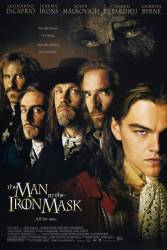Continuity mistake: The mask that is removed from Leo has 3 parts - a face mask which is held onto Leo's head, with a 2 piece hinged cage that locks in the back. In the flashback, where they show Leo being put in the mask, it is only 2 pieces. The face part is fused to the hinged cage section.
Continuity mistake: When the Jesuit tries to kill King Louis, Louis grabs a long bladed knife and stabs the Jesuit in the chest, but when the camera pulls back, the knife is gone, and no one has made a move to pull it out of his chest. Only the blade that D'Artanian threw at him is there.
Continuity mistake: D'Artagnan's three best friends who have known him for over twenty years pronounce his name three different ways. Only the stupid one, Porthos (Gerard Depardieu) gets it right. "Athos" is also pronounced several different ways: either a hard or soft initial 'A,' and with the 'h' either pronounced or silent. Sometimes the name is pronounced different ways in different scenes by the same character.
Continuity mistake: Near the end, when D'Artagnan is dying, we can see Athos lying with D'Artagnan's head on his lap, with his head right behind him, yet in the next take, he's sat bolt upright, far from his friend's head. It changes from take to take.
Continuity mistake: Close to the end of the film, when D'Artagnan is helping everyone escape through a back door of the Bastille, he says "Don't stop until you reach the river" and we see the door opening with all the characters in a particular order. I believe Athos is on the left of Phillippe. In the next shot, we see the same door opening from the outside and now the characters are lined up to exit in a completely different order. Athos is now on the right of Phillippe.
Continuity mistake: Towards the end of the movie, (when he gets in the shallow boat with the Musketeers and Louis), Phillipe seems to have red bows on his court boots, yet when he was at the masked ball the bows were gone.
Continuity mistake: When Phillipe stands up to look in the water bin after he had his mask removed, he places only his left hand on the bin's edge. But in the next shot of him looking in the water, his right hand is on the edge instead of the left.
Continuity mistake: Why is the same red rose used throughout the film? If it was real over the amount of time in the film the rose would be long dead. Look at the branching of the rose and you will see what I mean.
Continuity mistake: We see D'Artagnan's grave at the end, and there is no flower on it. We then see the queen mother who is holding a rose, but she walks off with it. Cut back to the grave, and a rose has suddenly appeared there.
Continuity mistake: When D'Artagnan dies, Philippe has his right hand up on the side of D'Artagnan's face. But when it cuts to the wide shot Philippe has moved down quite a bit, and his right hand is on D'Artagnan's chest.
Continuity mistake: When Louis hits Phillippe when they are in the Palace, it seems he hits the right side of his face, but Phillippe falls holding the left side.
Continuity mistake: When Phillipe is having his mask removed after being rescued from the Bastille, he touches both sides of his face with his hands in a close shot of him. But when it goes to a wider shot of him and the rest of the men, when he turns to look at the water bin, his hands are no longer touching his face. There wasn't time to bring them back down.
Continuity mistake: After King Louis stabs d'Artagnan with the dagger, the good brother (Phillipe), rushes him and Louis drops the dagger to the prison floor. However, in the next scene, a close-up of the two brothers fighting, Louis has the dagger in his hand again.






Answer: There would be both genetic similarities and individual differences, and their vocabularies would have developed differently by education and experience. However, Phillipe was heavily tutored before the switch took place, and as "king" he would be able to distance himself (physically, mentally, and emotionally) as much as needed from members of his court until he perfected his role, along with the continued help from those in on the deception. Also, the audience and readers of the novel are expected to employ a certain "suspension of disbelief" in order to allow the story to be told.
raywest ★